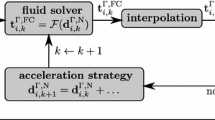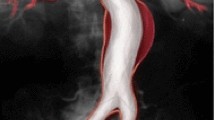Abstract
Unsteady fluid-structure interaction (FSI) simulations are generally time-consuming. Gradient-based methods are preferred to minimise the computational cost of parameter identification studies (and more in general optimisation) with a high number of parameters. However, calculating the cost function’s gradient using finite differences becomes prohibitively expensive for a high number of parameters. Therefore, the adjoint equations of the unsteady FSI problem are solved to obtain this gradient at a cost almost independent of the number of parameters. Here, both the forward and the adjoint problems are solved in a partitioned way, which means that the flow equations and the structural equations are solved separately. The application of interest is the identification of the arterial wall’s stiffness by comparing the motion of the arterial wall with a reference, possibly obtained from non-invasive imaging. Due to the strong interaction between the fluid and the structure, quasi-Newton coupling iterations are applied to stabilise the partitioned solution of both the forward and the adjoint problem.






Similar content being viewed by others
References
Balasubramanian R, Newman J (2006) Discrete direct and adjoint sensitivity analysis for arbitrary Mach number flows. Int J Numer Methods Eng 66(2):297
Bertoglio C, Moireau P, Gerbeau JF (2012) Sequential parameter estimation for fluid-structure problems. Application to hemodynamics. Int J Numer Methods Biomed Eng 28:434–455. doi:10.1002/cnm.1476
Bonnet M, Constantinescu A (2005) Inverse problems in elasticity. Inverse Probl 21(2):R1
Causin P, Gerbeau JF, Nobile F (2005) Added-mass effect in the design of partitioned algorithms for fluid-structure problems. Comput Methods Appl Mech Eng 194(42–44):4506
Cowper G (1966) The shear coefficient in Timoshenko’s beam theory. J Appl Mech 33(2):335
Degroote J, Bruggeman P, Haelterman R, Vierendeels J (2008) Stability of a coupling technique for partitioned solvers in FSI applications. Comput Struct 86(23–24):2224
Degroote J, Bathe KJ, Vierendeels J (2009) Partitioned simulation of the interaction between an elastic structure and free surface flow. Comput Struct 87(11–12):793
Degroote J, Annerel S, Vierendeels J (2010a) Stability analysis of Gauss-Seidel iterations in a partitioned simulation of fluid-structure interaction. Comput Struct 88(5–6):263
Degroote J, Haelterman R, Annerel S, Bruggeman P, Vierendeels J (2010b) Performance of partitioned procedures in fluid-structure interaction. Comput Struct 88(7–8):446
Eberhart R, Shi Y, Kennedy J (2001) Swarm intelligence. Morgan Kaufmann, San Mateo
Farhat C, van der Zee K, Geuzaine P (2006) Provably second-order time-accurate loosely-coupled solution algorithms for transient nonlinear computational aeroelasticity. Comput Methods Appl Mech Eng 195(17–18):1973
Fazzolari A, Gauger N, Brezillon J (2007) Efficient aerodynamic shape optimization in MDO Context. J Comput Appl Math 203(2):548
Felippa C, Park K, Farhat C (2001) Partitioned analysis of coupled mechanical systems. Comput Methods Appl Mech Eng 190(24–25):3247
Formaggia L, Lamponi D, Quarteroni A (2003) One-dimensional models for blood flow in arteries. J Eng Math 47(3–4):251
Gauger N, Fazzolari A (2009) MegaDesign and MegaOpt—German initiatives for aerodynamic simulation and optimization in aircraft design, results of the closing symposium of the MegaDesign and MegaOpt projects, Braunschweig, Germany, 23–24 May 2007. Adjoint methods for coupled CFD–CSM optimization. In: Notes on numerical fluid mechanics and multidisciplinary design, vol 107. Springer, Berlin, pp 237–246
Gee M, Küttler U, Wall W (2011) Truly monolithic algebraic multigrid for fluid-structure interaction. Int J Numer Methods Eng 85(8):987
Gerbeau JF, Vidrascu M (2003) A quasi-Newton algorithm based on a reduced model for fluid-structure interaction problems in blood flows. ESAIM: Math Model Numer Anal 37(4):631
Goldberg D (1989) Genetic algorithms in search optimization and machine learning. Addison Wesley, Reading
Gorissen D, Couckuyt I, Demeester P, Dhaene T, Crombecq K (2010) A surrogate modeling and adaptive sampling toolbox for computer based design. J Mach Learn Res 11:2051
Griewank A, Walther A (2000) Algorithm 799: revolve: an implementation of checkpointing for the reverse or adjoint mode of computational differtiation. ACM Trans Math Softw 26(1):19
Haelterman R, Degroote J, Van Heule D, Vierendeels J (2009) Analytical study of the least squares quasi-Newton method for interaction problems. SIAM J Numer Anal 47(3):2347
Haelterman R, Degroote J, Van Heule D, Vierendeels J (2010) On the similarities between the quasi-Newton inverse least squares method and GMRes. SIAM J Numer Anal 47(6):4660
Heil M (2004) An efficient solver for the fully coupled solution of large-displacement fluid-structure interaction problems. Comput Methods Appl Mech Eng 193(1–2):1
Hojjat M, Stavropoulou E, Gallinger T, Israel U, Wüchner R, Bletzinger KU (2010) Fluid-structure interaction in the context of shape optimization and computational wind engineering. In: Bungartz HJ, Mehl M, SchäferM (eds) Fluid-structure interaction II: modelling, simulation, optimization. Lecture notes in computational science and engineering. Springer, Berlin, pp 351–381
Hübner B, Walhorn E, Dinkler D (2004) A monolithic approach to fluid-structure interaction using space-time finite elements. Comput Methods Appl Mech Eng 193(23–26):2087
Kennedy G, Hansen J, Martins J (2011) A Timoshenko beam theory with pressure corrections for layered orthotropic beams. Int J Solids Struct 48(16–17):2373
Kirkpatrick S, Gelatt C, Vecchi M (1983) Optimization by simulated annealing. Science 220(4598):671
Küttler U, Wall W (2008) Fixed-point fluid-structure interaction solvers with dynamic relaxation. Comput Mech 43(1):61
Lagrée PY (2000) An inverse technique to deduce the elasticity of a large artery. Eur Phys J Appl Phys 9(2):153
Li F, Sun Z (2007) A finite difference scheme for solving the Timoshenko beam equations with boundary feedback. J Comput Appl Math 200(2):606
Martin V, Clément F, Decoene A, Gerbeau JF (2005) Parameter identification for a one-dimensional blood flow model. ESAIM: Proc 14:174
Martins J, Alonso J, Reuther J (2004) High-fidelity aerostructural design optimization of a supersonic business jet. J Aircr 41(3):523
Martins J, Alonso J, Reuther J (2005) A coupled-adjoint sensitivity analysis method for high-fidelity aero-structural design. Optim Eng 6(1):33
Maute K, Nikbay M, Farhat C (2001) Coupled analytical sensitivity analysis and optimization of three-dimensional nonlinear aeroelastic systems. Am Inst Aeron Astron J 39(11):2051
Maute K, Nikbay M, Farhat C (2003) Sensitivity analysis and design optimization of three-dimensional nonlinear aeroelastic systems by the adjoint method. Int J Numer Methods Eng 56(6):911
Mok D, Wall W, Ramm E (2001) Accelerated iterative substructuring schemes for instationary fluid-structure interaction. In: KJ Bathe (ed) Computational fluid and solid mechanics. Elsevier, Amsterdam, pp 1325–1328
Michler C, van Brummelen E, de Borst R (2005) An interface Newton–Krylov solver for fluid-structure interaction. Int J Numer Methods Fluids 47(10–11):1189
Nielsen E, Diskin B, Yamaleev N (2009) Discrete adjoint-based design optimization of unsteady turbulent flows on dynamic unstructured grids. In: 19th AIAA computational fluid dynamics conference (San Antonio, TX, USA), pp 1–22. AIAA 2009-3802
Nocedal J, Wright S (1999) Numerical optimization. Springer series in operations research. Springer, New York
Palaniappan K, Sahu P, Alonso J, Jameson A (2006) Active flutter control using an adjoint method. In: 44th AIAA aerospace sciences meeting and exhibit (Reno, NV, USA), pp 1–11. AIAA 2006-844
Palaniappan K, Sahu P, Alonso J, Jameson A (2009) Design of adjoint based laws for wing flutter control. In: 47th AIAA aerospace sciences meeting (Orlando, FL, USA), pp 1–20. AIAA 2009-148
Papadimitriou D, Giannakoglou K (2008) Direct, adjoint and mixed approaches for the computation of Hessian in airfoil design problems. Int J Numer Methods Fluids 56(10):1929
Quarteroni A, Tuveri M, Veneziani A (2000) Computational vascular fluid dynamics: problems, models and methods. Comput Visual Sci 2(4):163
Rumpfkeil M, Zingg D (2010) The optimal control of unsteady flows with a discrete adjoint method. Optim Eng 11(1):5
Sternberg J, Griewank A (2006) Reduction of storage requirement by checkpointing for time-dependent optimal control problems in ODEs. In: Automatic differentiation: applications, theory, and implementations. Lecture notes in computational science and engineering, vol 50. Springer, Berlin, pp 99–110
Stück A, Camelli F, Löhner R (2010a) Adjoint-based design of shock mitigation devices. Int J Numer Methods Fluids 64(4):443
Stück A, Camelli F, Löhner R (2010b) Adjoint-based design of shock mitigation devices. In: 48th AIAA aerospace sciences meeting (Orlando, FL, USA), pp 1–30. AIAA 2010-1430
van Brummelen E (2009) Added mass effects of compressible and incompressible flows in fluid-structure interaction. J Appl Mech 76(2):021206
van Brummelen E (2011) Partitioned iterative solution methods for fluid-structure interaction. Int J Numer Methods Fluids 65(1–3):3
Vierendeels J, Riemslagh K, Dick E (1999) A multigrid semi-implicit line-method for viscous incompressible and low-Mach-number flows on high aspect ratio grids. J Comput Phys 154(2):310
Vierendeels J, Dumont K, Dick E, Verdonck P (2005) Analysis and stabilization of fluid-structure interaction algorithm for rigid-body motion. AIAA J 43(12):2549
Vignon-Clementel I, Figueroa C, Jansen K, Taylor C (2010) Outflow boundary conditions for 3D simulations of non-periodic blood flow and pressure fields in deformable arteries. Comput Methods Biomech Biomed Eng 13(5):625
Wang Q, Moin P, Iaccarino G (2009) Minimal repetition dynamic checkpointing algorithm for unsteady adjoint calculation. SIAM J Sci Comput 31(4):2549
Wüchner R, Kupzok A, Bletzinger KU (2007) A framework for stabilized partitioned analysis of thin membrane-wind interaction. Int J Numer Methods Fluids 54(6–8):945
Acknowledgement
Joris Degroote gratefully acknowledges funding by a post-doctoral fellowship of the Research Foundation—Flanders (FWO).
Author information
Authors and Affiliations
Corresponding author
Rights and permissions
About this article
Cite this article
Degroote, J., Hojjat, M., Stavropoulou, E. et al. Partitioned solution of an unsteady adjoint for strongly coupled fluid-structure interactions and application to parameter identification of a one-dimensional problem. Struct Multidisc Optim 47, 77–94 (2013). https://doi.org/10.1007/s00158-012-0808-2
Received:
Revised:
Accepted:
Published:
Issue Date:
DOI: https://doi.org/10.1007/s00158-012-0808-2




